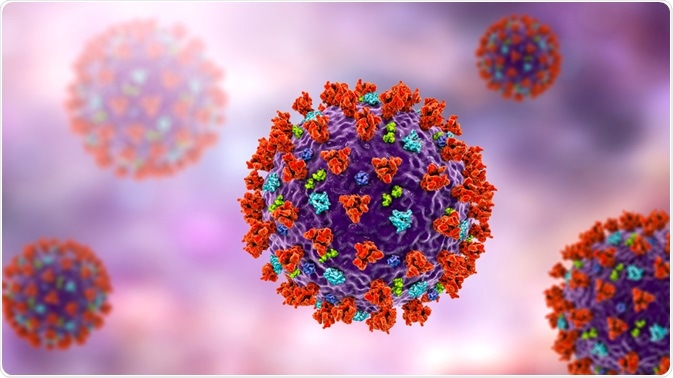In order to develop appropriate treatments and vaccines to combat the novel coronavirus, otherwise known as severe acute respiratory syndrome coronavirus 2 (SARS-CoV-2), researchers around the world have carefully examined every microscopic component of this potent virus.

Image Credit: Kateryna Kon/Shutterstock.com
This research has led to the discovery that the furin protease may play a key role in facilitating the entry of the SARS-CoV-2 into human cells.
What is protease?
The term protease is used to describe a large group of diverse hydrolytic enzymes. Proteases are often characterized by their active site structure, specific reaction mechanisms, and site of action.
Like many other enzymes, proteases can participate in a wide range of both biochemical and physiological processes throughout the body that directly impact the function of individual cells, as well as the organism as a whole.
Some specific roles of proteases in the body include nutrition maintenance, protein turnover, growth, adaptation, regulation, sporulation, germination, disease, and eventually death. It is estimated that the human genome encodes more than 550 different proteases.
What is furin?
Originally identified in 1990, furin is a cellular endoprotease that proteolytically activates many proprotein substrates ranging from pathogenic agents to growth factors, receptors, and extracellular matrix proteins.
Like other endoproteases, furin’s mechanism of action is due to the hydrolysis of peptides and protein substrates at specific internal peptide bonds.
The actions of furin play critical roles throughout every stage of life, beginning with its processing of pro-b-nerve growth factor (NGF) that allow for neuronal innervation to take place during development and continuing until the late stage of life during amyloid dementia.
Virus pathogenicity by furin
The role that furin has in the activation of a diverse population of pathogens was originally identified through biochemical experiments on anthrax toxin protective antigen (PA) and avian influenza virus haemagglutinin (HA).
Following exposure to anthrax, for example, furin is responsible for the cleavage of this toxin, which is a crucial step in allowing the toxin to form pores in target cell membranes and eventually penetrate host cells.
A similar mechanism by furin is utilized by the avian influenza virus, as well as several other pathogenic viruses including HIV-1, measles, and respiratory syncytial virus (RSV) to increase their virulence. More specifically, these viruses often express envelope glycoproteins on their surface.
The cleavage of these glycoproteins by furin allows for the mature and fusogenic envelope glycoprotein to develop. The Ebola Zaire and Ivory Coast strains have also been shown to contain a consensus furin site in their envelope glycoprotein that has been associated with certain cytotoxic actions of the highly lethal Ebola virus.
Furin and coronaviruses
The structure of the SARS-CoV-2 virus is surrounded by trimeric transmembrane spike (S) proteins that have proven to be critical in the mechanism by which this virus penetrates host cells.
Within the S protein exists two function domains, which include a receptor-binding domain and a second domain that allows for the virus to fuse with the phospholipid membrane of host cells.
To allow for the fusion between the viral and cell membranes to occur, a certain type of protease is typically involved; however, the specific characteristics of this protease can differ between coronaviruses. For example, the S protein that surrounds the Middle East respiratory syndrome (MERS)-CoV virus contains a furin cleavage site that promotes the entry of this virus into the cells.
Comparatively, the S protein of the severe acute respiratory syndrome (SARS)-CoV virus molecule is uncleaved after its fusion with a host cell, thereby indicating that its cleavage occurs after the virus has already entered the cell.

Image Credit: Kateryna Kon/Shutterstock.com
Furin and SARS-CoV-2
The binding of the S protein to angiotensin-converting enzyme 2 (ACE2) has been determined to be a key mechanism in the penetration of SARS-CoV-2 into human cells. An investigation into the S protein of the SARS-CoV-2 identified four redundant furin cleavage sites.
Interestingly, furin proteases are found in abundant quantities throughout the respiratory tract, thereby causing researchers to postulate whether the cleavage of the SARS-CoV-2 S protein upon exiting epithelial cells can result in its highly infectious and pathogenic nature.
In addition to providing information as to why SARS-CoV-2 is so contagious between humans, the acquisition of these furin cleavage sites also provides researchers with information as to how this virus was able to successfully spread from bats to humans in the first place.
A recent study created a mutant SARS-CoV-2 that did not have the usual furin cleavage site. From their tests, they found that the mutant caused reduced disease but could still give some protection against the parental SARS-CoV-2. The findings suggest that the furin cleavage site on SARS-CoV-2 has a critical role in SARS-CoV-2 infection.
Conclusion
Unfortunately, much of the information surrounding furin proteases and their involvement in the spread and infection by the SARS-CoV-2 is still in its early stages and must be studied more thoroughly.
Studying the involvement of furin cleavage sites in the spread of SARS-CoV-2 may support the development of targeted therapeutic approaches, such as host protease inhibitors, in the near future.
References
- Alsibai, K. D. (2020). Expression of angiotensin-converting enzyme 2 and proteases in COVID-19 patients: A potential role of cellular FURIN in the pathogenesis of SARS-CoV-2. Medical Hypotheses 143. doi:10.1016/j.mehy.2020.109893.
- Braun, E., & Sauter, D. (2019). Furin-mediated protein processing in infectious diseases and cancer. Clinical & Translational Immunology 8(8). doi:10.1002/cti2.1073.
- Johnson, B.A., Xie, X., Bailey, A.L. et al. (2021). Loss of furin cleavage site attenuates SARS-CoV-2 pathogenesis. Nature doi.org/10.1038/s41586-021-03237-4
- Thomas, G. (2002). Furin at the cutting edge: From protein traffic to embryogenesis and disease. Nature Reviews Molecular Cell Biology 3(10); 753-766. doi:10.1038/nrm934.
- Ward, O. P. (2011). Proteases. Comprehensive Biotechnology 604-615. doi:10.1016/B978-0-444-64046-8.00187-7.
Further Reading